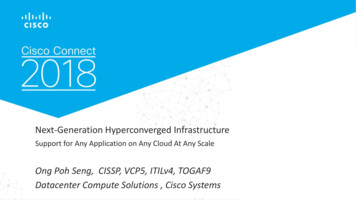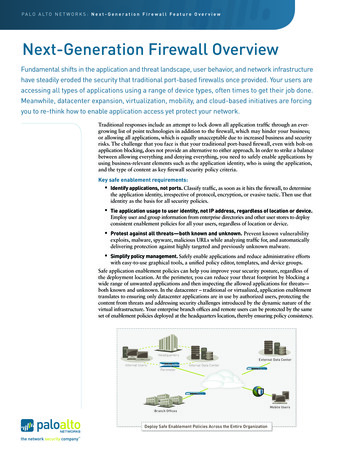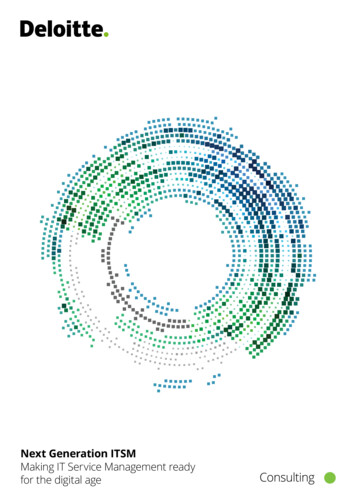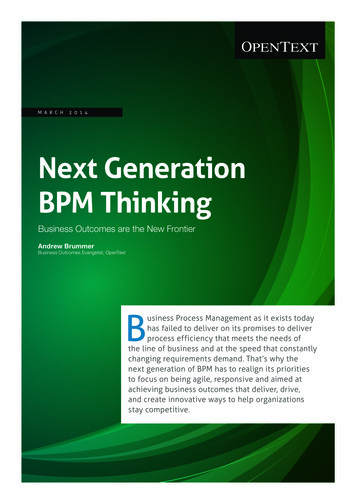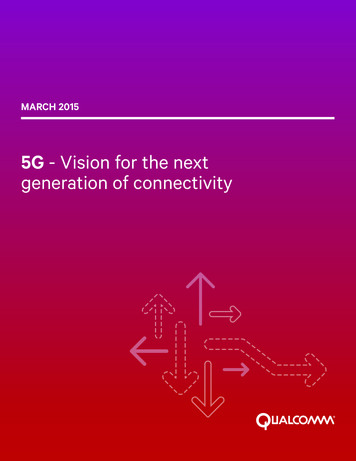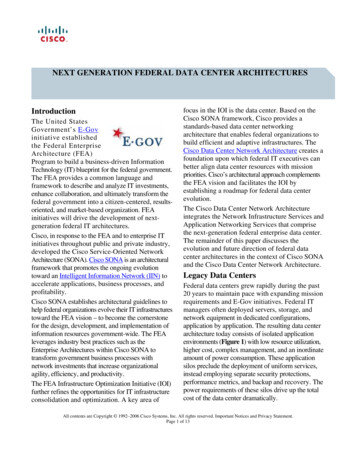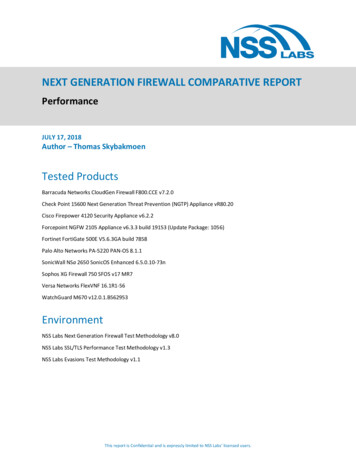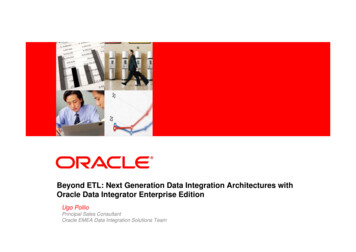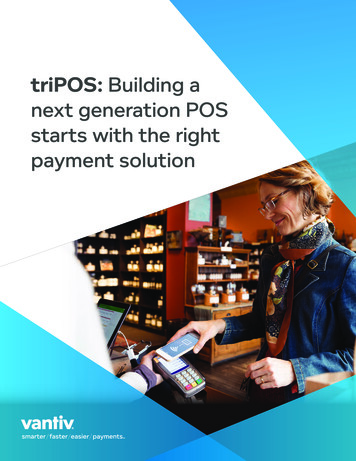
Transcription
triPOS: Building anext generation POSstarts with the rightpayment solution1
Developers of integrated point of sale (POS) applications face a variety of challenges. From the shiftto EMV, to concerns about security, developers have a lot on their plate. Merchants also increasinglydemand seamless customer experiences in-store, on the web and across mobile devices to meet thecommerce and payments demands of consumers. Integrated software vendors (ISVs) as a result race todeliver new functionality, to enhance and differentiate their offerings, and to provide new innovations forthe merchants they serve.In this paper, we discuss integrated payments, and the increasing importance of payment middleware.We explore how choosing the right technology in this area can help ISVs reduce development costs, andget to market faster with the cutting-edge features that merchants demand. We cover Vantiv’s triPOSproduct line in detail, and explain how together with Vantiv’s Express Gateway, triPOS can help simplifyand accelerate the development of next generation point of sale applications.INTEGRATED PAYMENTSModern POS platforms do much more than just acceptpayments quickly and reliably – they add intelligence at thepoint of sale, boosting efficiency, enabling new servicesthat delight customers, improve loyalty, and add to themerchant’s bottom line. As a few examples, integrated POSplatforms can: Enable reservations, provide wait list functionality, andmanage guest pagers in restaurants to improve efficiency,customer service, and boost revenue Increase brand and customer loyalty through gift-cardsand various promotions Offer enhanced services including cashback andadditional payment methods Manage inventory and interface with various back-officesystems including CRM, workforce management andaccounting platforms Generate detailed reports identifying the busiest timesof day, most popular products sold and performance ofvarious up-sell, cross-sell strategiesWhile integrated payment providers continue to innovatein a variety of industries, a common denominator behindall these systems is the need for fast, efficient and reliablepayments.2NEW CHALLENGES FOR ISVSAs point of sale providers compete to deliver newfunctionality, they face several challenges. Security: Merchants are increasingly concerned about avariety of security related issues like fraud, cyber-securityand the business risks posed by handling customer data. EMV Chip Cards: The EMV liability shift has givenmerchants a reason to revisit their POS and supplierrelationships as they modernize to support chip cards,leaving VARs and POS solution providers vulnerable todisplacement. Mobile: While adoption is slow, mobile wallet technologyis advancing quickly. Consumers increasingly expect NFCtap payments, and many businesses are implementing orpiloting functionality like order-ahead or pick-up-in-storewith mobile app integrations to give them a leg-up oncompetitors. Omnichannel: With the rise of eCommerce, as merchantsrevisit the POS, they are looking at payments moreholistically. They are seeking payment solutions thataddress all their payment channels including in-store,online and mobile devices.EMV poses several technical challenges for developers.Unlike mag stripe readers that appear as simple keyboarddevices to a host operating system and application, EMV
devices are considerably more complex. EMV readersinterface with micro-processor equipped smart cards andgenerate a unique cryptogram for every payment transaction.There are multiple options for EMV deployments that bothPOS providers and merchants need to grapple with. Unlikemag stripe readers, interfacing to EMV peripherals requiresbi-directional communication. Also, the software interfacesprovided by EMV device manufacturers are complex, makingthem time consuming and costly to integrate to, with eachmanufacturer exposing different APIs and their own valueadded feature sets.Every EMV acceptance solution, including the applicationand associated devices, requires certification with each cardbrand. This means that developers potentially need to revisitor recertify their applications and EMV integrations everytime they choose to support a new device, a manufacturer’supgrade to a device, or they make significant changes to theirsoftware. Clearly, integrating to EMV devices adds cost andcomplexity to the software development lifecycle.Aside from challenges specific to EMV, security broadly isan area of increasing concern for both merchants and ISVs.Fines potentially levied by banks and credit card institutionsfor PCI non-compliance can range anywhere from 5,000to 500,000 according to FocusonPCI.COM by NeoSpirePOS software architectureApplication LogicInc., depending on the PCI level and duration of the noncompliance period. Even for organizations that are fully PCIcompliant, fines can be levied in the range of 50 to 90per card holder¹ and suspension of credit card acceptance.This is in addition to brand damage and possible civillitigation from breached customers. For applications inPayment Application Data Security Standard (PA-DSS)scope, certifications can cost upwards of 30,000, furthercomplicating development and slowing time to market.SEMI-INTEGRATED: A BETTER APPROACHIn traditional integrated payment solutions, the softwarethat runs on the point of sale platform handles all facetsof the payment transaction. This includes reading frombarcode scanners, managing inventory and communicatingwith a payment provider to authorize credit card or debitcard payments. The challenge with this approach is that thesoftware on the POS is in PCI scope because it is handling,transmitting and potentially storing sensitive information.Also, if the POS provider is integrating directly to an EMVhardware device, they are required to certify their solutionwith the card brands as explained above.For most POS providers, a semi-integrated approach asshown in Figure 1 is a better solution. In a semi-integratedenvironment, the application logic that runs on the POS isde-coupled from the payment environment.Figure 1: A semi-integrated point of sale solutiondecouples application logic from paymentsisolated from pportedPin ntProcessorOperating SystemPeripheralsCash drawer, printer,barcode scanners etc.1. PCI non-compliance consequences - ci-noncompliant-consequences.html3
The point of sale application sends simple transaction datato secure payment middleware, for example, a requestto authorize a payment. The payment middleware thencommunicates with the payment terminal and managesthe process of relaying the transaction to the paymentprocessor, resulting in an approval or denial that is relayedback to the application.The triPOS product family is comprised of distinct solutionsdepending on the nature of the point of sale paymentsintegration. These include:In this environment, it is the payment middleware that iscertified by the card brands for various EMV devices andnot the point of sale application software itself. This meansthat application providers can change their software freelywithout needing to worry about recertification every timethey release a new version of their POS platform. triPOS mobile – An SDK for mobile platforms thatsimilarly manages various payment devices simplifyingintegration with mobile appsDepending on the implementation, developers can avoid theneed for the POS application to handle sensitive paymentinformation. This means that the POS application canpotentially be taken out of PA- DSS scope as well, furthersimplifying development and reducing costs.The challenge for developers is how to retain the benefitsof the integrated payment functionality where applicationshave full visibility to payment details (like card on filefunctionality, capturing customer identity, or dealing withtemporary communication outages as examples) in thissemi-integrated environment. This is where the functionalityof the payment middleware becomes important.TRIPOS: A SMARTER PLATFORM FOR THE MODERN POSPROVIDERSVantiv’s triPOS product line is a powerful solution for pointof sale application developers and ISVs. triPOS is certifiedfor use with multiple devices including Verifone Vx805, Mxseries (915/925) Ingenico iSC series (250/480) iPP series(320/350) and iCMP. triPOS PC – Payment application middleware that can bedistributed along with your Windows or Linux based POSapplications to simplify integration with various EMV, NFCand mag stripe capable devices triPOS cloud – Payment application middleware similarto triPOS PC, but hosted in the Microsoft Azure cloud,accessible via a REST API that allows your on-premisesor cloud resident POS solution to easily interface to onpremises payment terminalsAll of the members of the triPOS family (discussed in detailbelow) help ISVs avoid the need to certify to individual EMVdevices and additionally help reduce PA-DSS scope for theirapplications.By using triPOS, developers and ISVs become out-of-scopefor PA-DSS and EMV device certifications, and businessesbenefit from reduced PCI DSS scope when triPOS iscombined with point-to-point encryption (P2PE) andtokenization. A typical triPOS deployment involving triPOSPC is shown in figure 2.The triPOS client installs directly on a Windows orLinux operating system that controls the point of saleenvironment. Once installed, triPOS exposes a RESTful APIvia a web-server on an internal TCP/IP port that the pointof sale application uses to communicate to the triPOSmiddleware using JSON format messages.triPOS gives point of sale developers a single API to handlepayments. triPOS looks after communicating with EMVand NFC capable payment devices, and communicatingwith various payment processors through Vantiv’s ExpressGateway. The triPOS middleware is a conduit to the Expressgateway, so developers don’t need to worry about codingto Express directly unless they choose to do so for otherreasons.4
Figure 2- a sample triPOS PC deployment, coupledwith a separate eCommerce storefrontIn-storePOS applicationSupportedTerminalREST tewayor other paymentprocessorseCommerce applications communicate to Vantiv’sExpress gateway endpointeCommerceHosted payment pages also available for simplifiedeCommerce integrationseCommerce /mobile webcustomerseCommercestorefrontTRIPOS FEATURESThe triPOS payment API exposes its own set of featureswhile also exposing features of the Express Gateway.Express is an excellent solution for ISVs and merchants alikebecause it is a single gateway that can be used for bothcard-present (POS) and card-not-present (eCommerceand mobile) applications. It supports enhanced data andextended parameter sets so that ISVs can code theirapplications to maximize the chances of successfulauthorizations. Providing rich data also help merchantsqualify for the best possible interchange rates, a key sellingpoint for merchants.Among the capabilities supported by triPOS are: Lane management functionality for stores with multiplecheckout locations Broad payment support: Credit, Debit, EMV, FSA & EBT Cashback functionality Store N Forward functionality (for PC and mobile only) Convenience fee support Incremental authorizations Account updater functionality Gift card support Tokenized transactions Validated point to point encryption (P2PE) Support for multiple payment processors: Vantiv, FirstData, Global Payments, Chase Paymentech among themtriPOS also exposes numerous features of the ExpressGateway that serve vertical market requirements in retail,eCommerce, Direct Marketing, Auto Rental and Lodging. Thismakes it easier for POS ISVs to enhance their applications toaddress new market requirements. Some examples are: Restaurants: Support for tip amounts and authorizationcompletions Hotel / lodging: Lodging program codes, prestigiousproperty codes, check-in / check-out dates, room amounts,room taxes, no show indicators, stay durations etc. Automotive: Pickup & drop off dates and locations,agreement numbers, no show indicators, rental durations,vehicle classification codes, distance traveled, auditadjustment codes etc. Recurring and scheduled payment transactions (viainterfaces to Express)5
Healthcare: Support for Visa and MasterCard Healthcare/FSA cards with multiple healthcare account types andamount types, healthcare charge types (clinic, dental,prescription, vision etc.)libraries or SDKs. They can simply write to the REST API specallowing the triPOS middleware and the application softwareto be upgraded independently of one another.TRIPOS DEPLOYMENT MODELSBecause merchants have diverse needs for point of salesystems, triPOS can be deployed in various configurations.triPOS can be embedded in the point of sale platform, it canbe used with a tablet based mobile acceptance solution,or the payment middleware can reside in a Vantiv managedcloud service (presently Microsoft Azure). The variousdeployment models are each discussed briefly below. No need to certify or recertify application software withEMV capable devicesAmong the advantages of triPOS PC to POS providers are: Reduced PA-DSS scope and certification related costs Have complete control over the packaging of the POSand the merchant experience by distributing the triPOSsoftware along with your POS platformTRIPOS PCAn example deployment of triPOS PC is pictured in Figure2. This is also referred to as triPOS Distributed, becausethe triPOS software is distributed by the ISV along withthe POS solution. As explained previously, the software isself-contained and installs on Windows or Linux. The POSapplication software communicates to triPOS via a RESTAPI exposed by an internal web-server. This provides a cleandemarcation point between the ISVs application softwareand the functionality provided by triPOS. By providing a cleanREST API, developers don’t need to worry about client-sideMobile device running POS appwith Vantiv’s triPOS mobile SDKTRIPOS MOBILEFor developers building POS solutions on mobile tablets,triPOS Mobile provides similar functionality as triPOSPC except that it runs on iOS and soon, Android as well.Merchants can continue to use supported EMV terminalsusing wired or Bluetooth connections, but the business logicis driven from the mobile device. ISVs can help merchantssupplement the in-store mobile point of sale solution witheCommerce capabilities with a website or mobile app thatcommunicates directly through the Express Gateway usingthe same Merchant ID (MID). Vantiv offers various solutionsto make it easy to add eCommerce functionality includinghosted checkout page support.Figure 3- triPOS mobile allows ISVs and developers tobuild mobile POS solutionstriPOSINTERNETInternetgatewayEMV-enabled Pin Pad withwired or wireless connection6ExpressPaymentGatewayor other paymentprocessors
triPOS mobile provides an SDK that simplifies coding to the“point-of interaction” (POI) devices supported by triPOS.The SDK provides an abstraction layer that developers canuse to create interactions on a payment terminal (displayingtext, accepting keyboard inputs or obtaining yes / noanswers to questions as examples) without the need towrite code for each specific terminal. The SDK also simplifiessetting up and communication payment transactionsthrough the Express Gateway.Among the benefits of the triPOS Mobile solution are: No need to certify or recertify application software withEMV capable devices Reduced PA-DSS scope and certification related costs Drive payment interactions directly from a mobile tabletanywhere in the store Easy integration to EMV payment devices via Bluetooth A lower cost, easier to support POS solution for smallmerchants Store and forward (offline transaction functionality)TRIPOS CLOUDtriPOS Cloud is the newest deployment model for thetriPOS payment middleware. It uses a software-as-aservice (SaaS) deployment model to simplify installationand ongoing maintenance. For ISVs moving all or part oftheir POS functionality to the cloud to improve flexibility orreduce costs, triPOS Cloud can be a good choice.In the cloud deployment model, the triPOS software ishosted by Vantiv, and the REST API is exposed via theinternet. Merchants can connect to the cloud service froman on-premises POS or may choose to implement their POSapplication logic entirely in the cloud and make it accessibleto merchants through any device capable of accessingthe internet. EMV PIN Pads will continue to reside at themerchant’s location as points of interaction, but othersoftware components can reside in the cloud.Lane management features in triPOS Cloud allowintegrators to pair multiple payment terminals to the cloudservice. Figure 4 illustrates the interaction between a POSprovider’s software running in the cloud, the PIN Pad (onpremises), triPOS Cloud, and the Express payment gateway,also running in the cloud.Figure 4The POS application interactswith the triPOS Cloud REST S application runningas a cloud servicetriPOS CloudExpressPaymentGatewayor other paymentprocessorsOne or more EMV P2PEPIN Pads at themerchant location pairedto cloud service7
At present, Verifone’s Mx915 is certified for use withtriPOS Cloud and additional devices are on the way. TheMx915 provides a bright 4.3 inch color display and supportsEMV chip cards, swipe transactions as well as NFC tapfunctionality allowing customers to pay using Mobile walletssuch as Apple Pay and Android Pay.Among the benefits of the triPOS Cloud solution are: No need to certify or recertify application software withEMV capable devices Reduced PA-DSS scope and certification related costs ISVs don’t need to worry about packaging, deploying ormaintaining the triPOS software Application software can be updated independently oftriPOS ISVs have increased deployment flexibility with the optionto deploy POS application services on premises or in thecloud, leveraging triPOS cloud in the same mannerSUMMARYFor point-of-sale application developers, choosing theright payment middleware is an important decision. ISVsneed a solution that allows them to easily access the latestEMV capable hardware without the need to re-certify theirapplication to every device. They also need strategies tohelp reduce PCI scope so they can spend their time focusingon the functionality of their application and the merchantsthey serve.Vantiv’s triPOS payment middleware is a powerful solutionthat supports a variety of deployment models. It supportsstate-of-the-art EMV Pin Pads and simplifies applicationdevelopment by avoiding the need to code to multiplephysical devices. Instead, developers code to a single,easy-to-use REST API, insulating them from the underlyinghardware and helping them reduce PCI scope.The triPOS middleware connects to Vantiv’s ExpressGateway, a high-performance, flexible gateway that exposesrich functionality for multiple industry verticals. The gatewaysupports both card present and card not present featuresallowing developers to use a single gateway for point of sale,eCommerce and mobile applications, enable developers tosupport a variety of omnichannel use cases.To learn more about Vantiv Integrated Payments solutions please of-saleFor technical information triPOS and its various deployment options, developers can of-sale/pages/integrationsVDI074 07.17
As point of sale providers compete to deliver new . for use with multiple devices including Verifone Vx805, Mx series (915/925) Ingenico iSC series (250/480) iPP series (320/350) and iCMP. . or cloud resident POS solu
